Using existing models for out-of-sample data#
By resampling the data, existing models can be used in preparations or recording conditions they were not trained on, without the need to train a new model. Here, we try to apply the model trained on cerebellar GC mEPSCs on mEPSPs (current-clamp data). In this scenario, there are several differences to the trainig data: mEPSPs are upward and the kinetics are slower. In addition, the recording mode is different, which may impact the noise characteristics of the data.
If the performance is satisfactory, we can use the model with some small parameter adjustments, if not we can opt to train a new model using transfer learning.
import sys
sys.path.append('../../core/')
from miniML import MiniTrace, EventDetection
from miniML_plot_functions import miniML_plots
Running miniML#
Generating the trace object works the same as in the miniML tutorial.
filename = '../../example_data/gc_mEPSP_mini_trace.h5'
scaling = 1e3
unit = 'mV'
# get from h5 file
trace = MiniTrace.from_h5_file(filename=filename,
tracename='mini_data',
scaling=scaling,
unit=unit)
Let’s plot and inspect the loaded data:
trace.plot_trace()
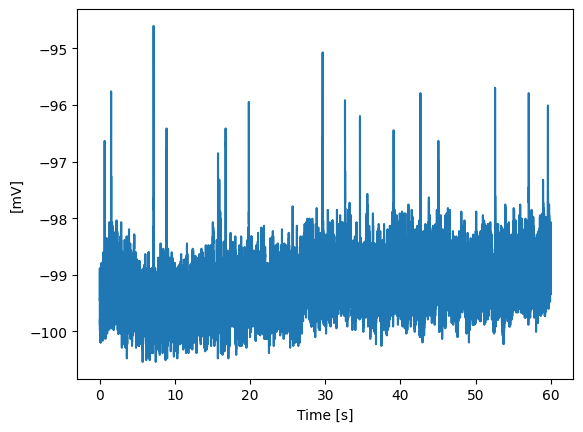
Creating and initializing a miniML EventDetection object also works very similar. Two things should be considered when using a model for an out-of-sample preparation:
direction parameters: “event_direction” specifies the direction of the events in the data. In this case, we have to change it to “positive”, because mEPSPs are positive.
“training_direction” specifies the direction of the events during model training. Here we use the GC mEPSC model, so the training_direction has to be set to “negative”.
Window size (here: variable win_size) has to be specified: This parameter, together with “resample_to_600” (see one cell later), effectively control the resampling. resample_to_600 can be either True (default) or False. If True, the data will be resampled to match a win_size of 600 for inference, based on the indicated window size. E.g. for win_size = 6000, the data would be downsampled by a factor of 10. This is necessary, because after training, the input size for a given model is fixed. This also goes for models that were trained using transfer learning: because the first layers are frozen, the input size remains unchanged during TL, and will be identical to the input size of the base model. So, instead of actually adjusting the input size, we resample the data for inference, to achieve the same effect.
The GC mEPSC model was trained with a window size of 600 points. This was big enough to fully capture one mEPSC, but is too small for mEPSPs, which have slower kinetics. But before we adjust win_size, let’s use the model with the standard value of 600 points (no resampling) and only the adjusted event_direction, to see how it performs:
model = '../../models/GC_lstm_model.h5'
win_size = 600 # Stays the same for now
threshold = 0.5
event_direction = 'positive'
training_direction = 'negative'
detection = EventDetection(data=trace,
model_path=model,
window_size=win_size,
model_threshold=threshold,
batch_size=512,
event_direction=event_direction,
training_direction=training_direction,
compile_model=True,
verbose=2)
detection.detect_events(eval=True,
convolve_win=30,
resample_to_600=True)
MiniPlots = miniML_plots(data=detection)
MiniPlots.plot_prediction(include_data=True, plot_filtered_prediction=False, plot_filtered_trace=True, plot_event_params=False)
MiniPlots.plot_event_overlay()
Model loaded from ../../models/GC_lstm_model.h5
293/293 - 6s - 6s/epoch - 22ms/step
Event statistics:
-------------------------
Number of events: 27
Average score: 0.787
Event frequency: 0.4500 Hz
Mean amplitude: 0.5384 mV
Median amplitude: 0.4018 mV
Std amplitude: 0.5295 mV
CV amplitude: 0.983
Mean charge: 0.00232 pC
CV charge: 2.288
Mean 10-90 risetime: 0.672 ms
Mean half decay time: 1.744 ms
Tau decay: 4.093 ms
-------------------------
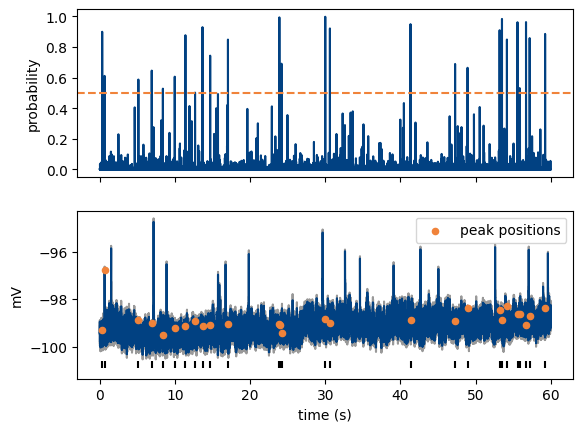
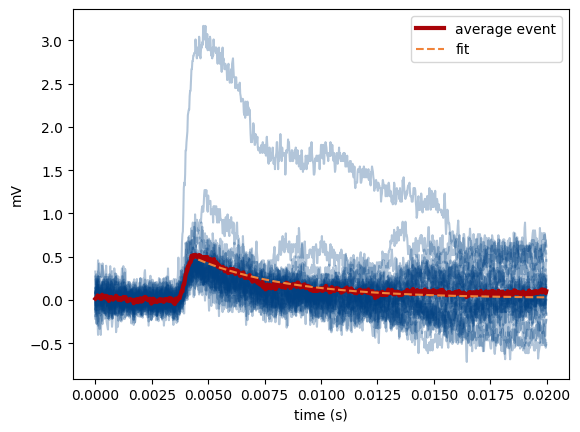
Clearly, the detection performance is not great and most of the larger mEPSPs are missed. Most detected events have very fast kinetics, faster than expected for mEPSPs. To potentially improve the performance in out-of-sample data, we can now adjust win_size. In this instance, the events are slower, so we need to choose a larger win_size, for example 3600, and make sure that resample_to_600 is set to True. Now the data will get downsampled by a factor of 6 for inference.
model = '../../models/GC_lstm_model.h5'
win_size = 3600 # Adjusted to resample data for inference.
threshold = 0.5
event_direction = 'positive'
training_direction = 'negative'
detection = EventDetection(data=trace,
model_path=model,
window_size=win_size,
model_threshold=threshold,
batch_size=512,
event_direction=event_direction,
training_direction=training_direction,
compile_model=True,
verbose=2)
detection.detect_events(eval=True,
convolve_win=30,
resample_to_600=True)
Model loaded from ../../models/GC_lstm_model.h5
49/49 - 1s - 1s/epoch - 25ms/step
Event statistics:
-------------------------
Number of events: 30
Average score: 0.955
Event frequency: 0.5000 Hz
Mean amplitude: 2.1119 mV
Median amplitude: 2.0384 mV
Std amplitude: 1.1756 mV
CV amplitude: 0.557
Mean charge: 0.02245 pC
CV charge: 0.713
Mean 10-90 risetime: 1.758 ms
Mean half decay time: 5.683 ms
Tau decay: 10.190 ms
-------------------------
Inspect the results#
%matplotlib inline
MiniPlots = miniML_plots(data=detection)
MiniPlots.plot_prediction(include_data=True, plot_filtered_prediction=False, plot_filtered_trace=True, plot_event_params=False)
MiniPlots.plot_event_overlay()
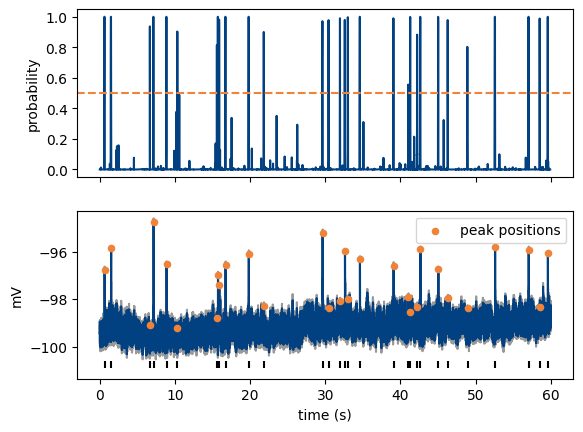
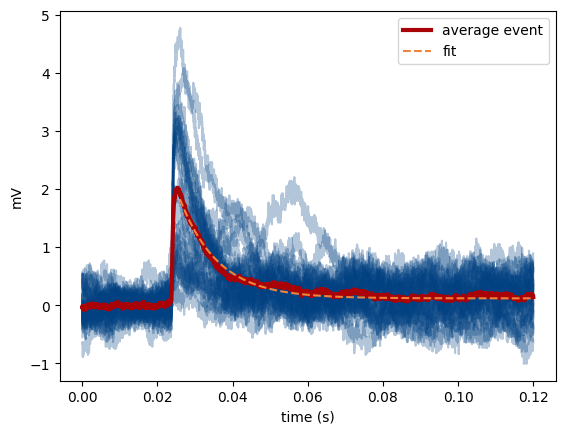
Now detection performance is much better, albeit not perfect. We could detect 30 mEPSPs in this trace (compared to 27 without resampling), and the shape of the detected events is much better (note the slower decay time of the detected events). The event scores (i.e., peak values of the model output) are also much better.
In this case, we decided to train a new model for GC mEPSPs (see tutorial_TL.ipynb and miniML_documentation.pdf), but in many cases, resampling the data, by adjusting the win_size parameter can work well enough, especially under otherwise consistent recording conditions (e.g. same rig with constant noise levels etc.).
